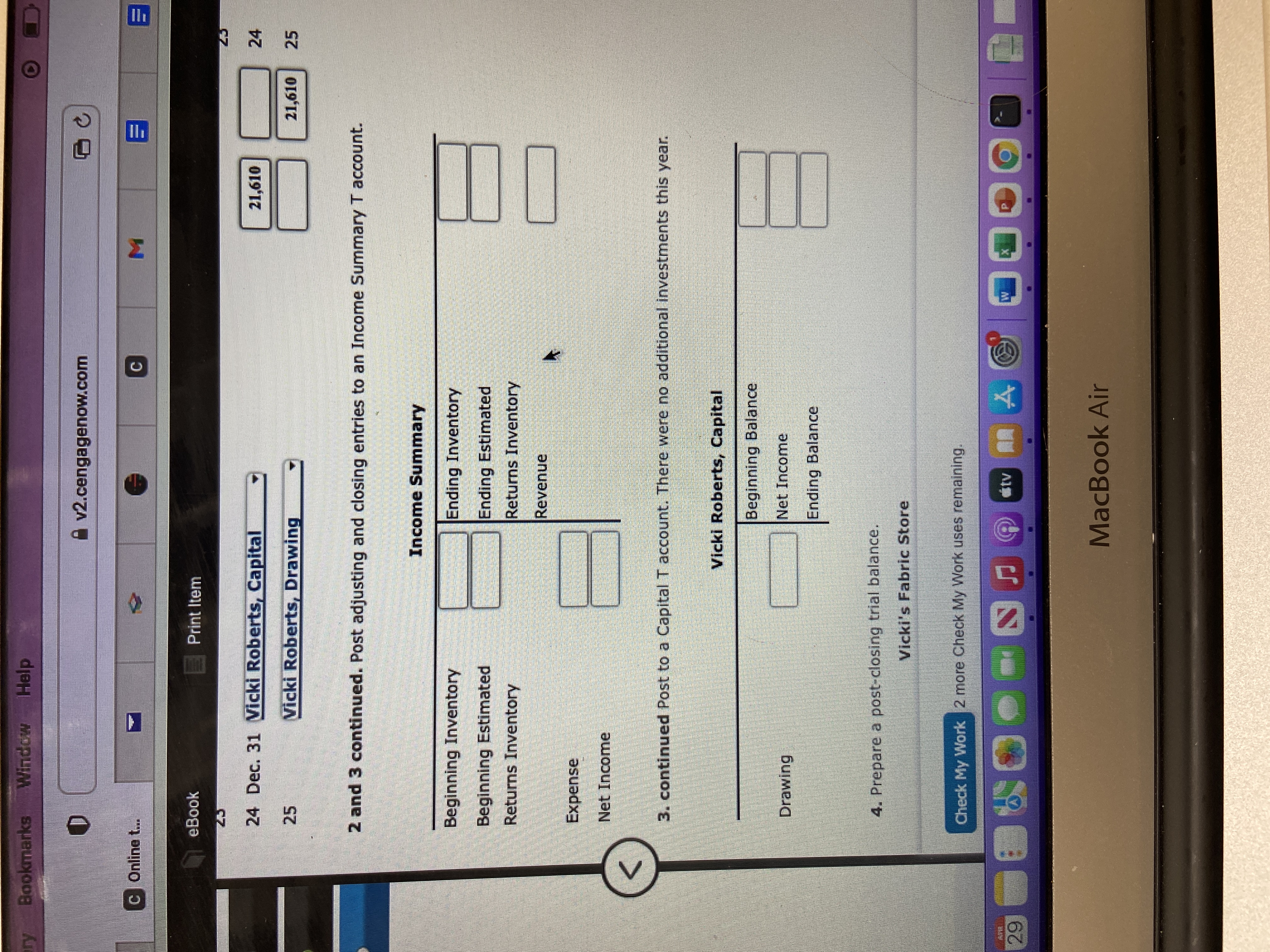Vicki’s Fabric Store shows the trial balance below as of December 31, 20-1. At the end of the year, the following adjustments need to be made: a., b. Merchandise inventory as of December 31, $31,600. c., d., e. Vicki estimates that customers will be granted $2,500 in refunds of this year’s sales next year and the merchandise expected to be returned will have a cost of $1,800. f. Unused supplies on hand, $350. g. Insurance expired, $2,400. h. Depreciation expense for the year on building, $20,000. i. Depreciation expense for the year on equipment, $4,000. j. Wages earned but not paid (Wages Payable), $520. k. Unearned revenue on December 31, 20-1, $1,200. Required Prepare an end-of-period spreadsheet. Prepare adjusting entries and post adjusting entries to an Income Summary T account. Prepare closing entries and post to a Capital T account. There were no additional investments this year. Prepare a post-closing trial balance. Prepare reversing entry(ies). *JOURNALIZE STEP 1,2,3,4 OF THE CLOSING PROCESS.*
Reporting Cash Flows
Reporting of cash flows means a statement of cash flow which is a financial statement. A cash flow statement is prepared by gathering all the data regarding inflows and outflows of a company. The cash flow statement includes cash inflows and outflows from various activities such as operating, financing, and investment. Reporting this statement is important because it is the main financial statement of the company.
Balance Sheet
A balance sheet is an integral part of the set of financial statements of an organization that reports the assets, liabilities, equity (shareholding) capital, other short and long-term debts, along with other related items. A balance sheet is one of the most critical measures of the financial performance and position of the company, and as the name suggests, the statement must balance the assets against the liabilities and equity. The assets are what the company owns, and the liabilities represent what the company owes. Equity represents the amount invested in the business, either by the promoters of the company or by external shareholders. The total assets must match total liabilities plus equity.
Financial Statements
Financial statements are written records of an organization which provide a true and real picture of business activities. It shows the financial position and the operating performance of the company. It is prepared at the end of every financial cycle. It includes three main components that are balance sheet, income statement and cash flow statement.
Owner's Capital
Before we begin to understand what Owner’s capital is and what Equity financing is to an organization, it is important to understand some basic accounting terminologies. A double-entry bookkeeping system Normal account balances are those which are expected to have either a debit balance or a credit balance, depending on the nature of the account. An asset account will have a debit balance as normal balance because an asset is a debit account. Similarly, a liability account will have the normal balance as a credit balance because it is amount owed, representing a credit account. Equity is also said to have a credit balance as its normal balance. However, sometimes the normal balances may be reversed, often due to incorrect journal or posting entries or other accounting/ clerical errors.
P 15-10A End-of-Period Spreadsheet, Adjusting, Closing, and Reversing Entries
Vicki’s Fabric Store shows the
At the end of the year, the following adjustments need to be made:
- a., b. Merchandise inventory as of December 31, $31,600.
- c., d., e. Vicki estimates that customers will be granted $2,500 in refunds of this year’s sales next year and the merchandise expected to be returned will have a cost of $1,800.
- f. Unused supplies on hand, $350.
- g. Insurance expired, $2,400.
- h.
Depreciation expense for the year on building, $20,000. - i. Depreciation expense for the year on equipment, $4,000.
- j. Wages earned but not paid (Wages Payable), $520.
- k. Unearned revenue on December 31, 20-1, $1,200.
Required
-
Prepare an end-of-period spreadsheet.
-
Prepare
adjusting entries and post adjusting entries to an Income Summary T account. -
Prepare closing entries and post to a Capital T account. There were no additional investments this year.
-
Prepare a post-closing trial balance.
-
Prepare reversing entry(ies).
*JOURNALIZE STEP 1,2,3,4 OF THE CLOSING PROCESS.*

Trending now
This is a popular solution!
Step by step
Solved in 5 steps with 5 images

I need the answer to closing entries . Part 2 and 3 continued for a T account . So confused









